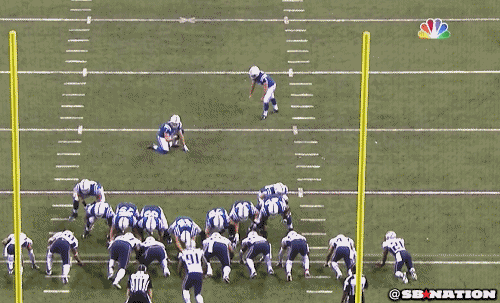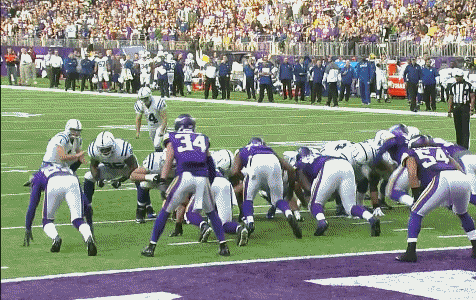In terms of reaction from the media and the public, the most controversial rule change is likely the ban of leaping over the line to block a kick. This difficult play has become extremely popular in the past couple seasons, and when executed well has brought an exciting element to an otherwise often forgettable part of games. If you watch the clip below and see Patriots linebacker Jamie Collins (91) jump over the snapper, it seems like a fairly safe play for all involved.
However, when a less athletic player, like Vikings defensive tackle Linval Joseph (98) tries to jump over the line, he puts all his weight onto the guard, who has his head and arms down and is therefore unable to protect himself from a player coming over the top. Joseph also puts himself at risk of falling on his head or neck when his legs come out from under him.
Prohibiting leaping over the line to block a kick may seem excessive, but it prevents defenseless linemen from being fallen on and prevents leapers from falling at dangerous angles. Besides, the majority of kicks are blocked by players shooting an outside gap or someone in the middle getting his arms in the air anyway, not by jumping over the line, so it's not like field goal blocks are being removed from the game entirely.
Speaking of defenseless players, another approved rule change is that all receivers who are running passing routes are now considered to be defenseless. What constitutes a "defenseless" player is subjective and often disputed, but in simple terms it's generally an offensive player who is making a certain type of motion that by its nature would prevent him from protecting himself from defenders. Some common examples would be a quarterback who is in the the motion of throwing a pass, or a receiver who is attempting to catch a pass. Because these players are unable to brace themselves for a collision or even see a hit coming, there are restrictions on where defenders are permitted to hit them; in the receiver example, the defenseless player can only be hit below the neck, and in the quarterback example, the passer can only be hit between the shoulders and thighs. Deeming all receivers who are running passing routes, even those who aren't thrown to, as being defenseless might seem extreme, but I think it's a good change that protects vicious contact that is often unseen because it happens away from the ball. In the NFL, defensive players are allowed to make contact with receivers who are running routes so long as the contact occurs within five yards of the line of scrimmage. This rule will remain; the only difference is that now, the contact put on receivers can't be to the head or neck areas.
 "Defenseless" players are not always on offense. Under NFL rules, defenders who are the recipients of crack blocks are also considered defenseless, and contact put on by receivers can't occur above the shoulders or below the waist. A crack block is a block where an outside receiver runs inside and blocks a defender who would normally be head-up over the inside receiver. In the diagram on the right, you can see the X receiver is lined up on the cornerback to start the play, and the Z receiver is presumably being watched by the outside linebacker who is between the left tackle and left guard. On a normal run to the outside, X would block the corner and Z would block the linebacker; however, on a crack block, the two receivers switch assignments. The corner will see the change coming as he sees the X receiver run in instead of towards him, but the linebacker, who is focusing on the Z receiver, won't even see X before X puts him on the ground. With the new rule change, the play on this diagram would still be legal. However, receivers are no longer to crack block if they are in motion and coming from the backfield. Now, receivers can't get a running start to crack blocks before the ball is snapped, therefore reducing the force involved in crack blocks and making it easier for defenders to track where blocks may be coming from.
"Defenseless" players are not always on offense. Under NFL rules, defenders who are the recipients of crack blocks are also considered defenseless, and contact put on by receivers can't occur above the shoulders or below the waist. A crack block is a block where an outside receiver runs inside and blocks a defender who would normally be head-up over the inside receiver. In the diagram on the right, you can see the X receiver is lined up on the cornerback to start the play, and the Z receiver is presumably being watched by the outside linebacker who is between the left tackle and left guard. On a normal run to the outside, X would block the corner and Z would block the linebacker; however, on a crack block, the two receivers switch assignments. The corner will see the change coming as he sees the X receiver run in instead of towards him, but the linebacker, who is focusing on the Z receiver, won't even see X before X puts him on the ground. With the new rule change, the play on this diagram would still be legal. However, receivers are no longer to crack block if they are in motion and coming from the backfield. Now, receivers can't get a running start to crack blocks before the ball is snapped, therefore reducing the force involved in crack blocks and making it easier for defenders to track where blocks may be coming from.One last rule approved by the Competition Committee is actually one that has been in place for the last year on a temporary basis, but now is considered permanent: a player who is penalized twice in the same game for certain types of unsportsmanlike conduct is now automatically disqualified from play. In the past, some people have called this rule the "Odell Beckham Rule," after Giants receiver Odell Beckham Jr received three personal fouls in a 2015 matchup against the Panthers yet was not ejected (he was later suspended for one game). Examples of unsportsmanlike conduct often include intentional helmet-to-helmet conduct, such as in the case of Beckham, and can also include things like punches or kicks.
The complete list of approved 2017 rule changes can be found here:
https://nflcommunications.com/Documents/2017%20Offseason/Approved%202017%20Playing%20Rules%20Proposals.pdf




